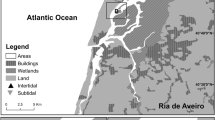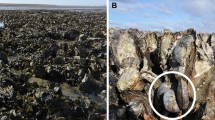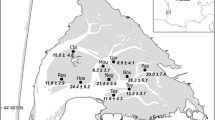Abstract
Zonation of organisms in soft-bottom intertidal habitats is mainly a consequence of the tidal sorting of the substrate and how benthic organisms respond to it, with predation and competition also playing a role. Although parasites are ubiquitous in these habitats and known agents of community structure, their impact on zonation is rarely considered. Here, using observational and experimental data, we show that parasitism of the cockle Austrovenus stutchburyi by echinostome trematodes has both direct and indirect effects on the zonation of four other animals associated with cockles on a New Zealand tidal flat. The trematodes encyst in the foot of cockles, leaving heavily infected cockles unable to bury and lying exposed on the sediment surface. Whereas cockle density peaks in the mid intertidal zone, both infection intensity by trematodes and density of surfaced cockles increase linearly towards the shore; this influences the vertical zonation of animals attaching to or feeding on cockles. First, the relative abundance of the whelk Cominella glandiformis increase exponentially shoreward, as does its rate of predation on cockles; the effect of the parasite on the cockles’ burying ability has thus shifted the peak abundance of whelk predators towards the upper tidal level, away from peak cockle densities. Second, the density of the anemone Anthopleura aureoradiata, corrected for the availability of its cockle substrate, peaks in the lower intertidal zone, although a transplantation experiment revealed that anemones can survive higher up the shore if attached to buried cockles. Anemones on exposed cockles are susceptible to desiccation, and thus again the parasite-induced surfacing of cockles at higher tidal levels plays a role by decreasing substrate availability for anemones. Third, densities of the limpet Notoacmea helmsi increase rapidly toward higher tidal levels, where limpets graze the surfaces of empty cockle shells or live surfaced cockles. The availability of both substrates used by limpets is influenced either directly (surfaced cockles) or indirectly (empty shells, via whelk predation) by parasitism. Fourth, the fish Notolabrus celidotus feeds on cockles by cropping their foot. Although the lower intertidal is submerged for longer and cockle densities peak in the mid intertidal, the frequency of foot-cropping by fish peaks in the upper tidal levels, where parasitism maintains a high density of surfaced cockles. Our results are the first demonstration that parasitism of a key species can influence the zonation of non-host organisms, a phenomenon likely to occur in other systems.








Similar content being viewed by others
References
Allison FR (1979) Life cycle of Curtuteria australis n. sp. (Digenea: Echinostomatidae: Himasthlinae), intestinal parasite of the South Island pied oystercatcher. NZ J Zool 6:3–20
Ansell AD (2001) Dynamics of aggregations of a gastropod predator/scavenger on a New Zealand harbour beach. J Moll Stud 67:329–341
Babirat C, Mouritsen KN, Poulin R (2004) Equal partnership: two trematode species, not one, manipulate the burrowing behaviour of the New Zealand cockle, Austrovenus stutchburyi. J Helminth 78:195–199
Bertness MD (1999) The ecology of Atlantic shorelines. Sinauer Associates, Sunderland, USA
Beukema JJ (1993) Successive changes in distribution patterns as an adaptive strategy in the bivalve Macoma balthica (L.) in the Wadden Sea. Helgol Meeresunters 47:287–304
Callaway RM, Pennings SC (1998) Impact of a parasitic plant on the zonation of two salt marsh perennials. Oecologia 114:100–105
Carrol H, Montgomery WI, Hanna REB (1990) Dispersion and abundance of Maritrema arenaria in Semibalanus balanoides in north-east Ireland. J Helminth 64:151–160
Combes C (1996) Parasites, biodiversity and ecosystem stability. Biodivers Conserv 5:953–962
Connell JH (1961) The influence of interspecific competition and other factors on the distribution of the barnacle Chthamalus stellatus. Ecology 42:710–723
Curtis LA (1987) Vertical distribution of an estuarine snail altered by a parasite. Science 235:1509–1511
Dayton PK (1971) Competition, disturbance and community organisation: the provision and subsequent utilization of space in a rocky intertidal community. Ecol Monogr 41:351–389
Desclaux C, de Montaudouin X, Bachelet G (2002) Cockle emergence at the sediment surface: ‘favourization’ mechanism by digenean parasites? Dis Aquat Org 52:137–149
Hiddink JG (2003) Modelling the adaptive value of intertidal migration and nursery use in the bivalve Macoma balthica. Mar Ecol Prog Ser 252:173–185
Hudson P, Greenman J (1998) Competition mediated by parasites: biological and theoretical progress. Trends Ecol Evol 13:387–390
Jensen KT (1992) Dynamics and growth of the cockle, Cerastoderma edule, on an intertidal mud-flat in the Danish Wadden Sea: effects of submersion time and density. Neth J Sea Res 28:335–345
Lambert TC, Farley J (1968) The effect of parasitism by the trematode Cryptocotyle lingua (Creplin) on zonation and winter migration of the common periwinkle, Littorina littorea (L.). Can J Zool 46:1139–1147
Lubchenco J (1978) Plant species diversity in a marine intertidal community: importance of herbivore food preference and algae competitive abilities. Am Nat 112:23–39
Menge BA (1976) Organization of the New England rocky intertidal community: role of predation, competition, and environmental heterogeneity. Ecol Monogr 46:355–393
Mikhailova NA, Granovich AI, Sergievski SO (1988) Effect of trematodes on the microbiotopical distribution of molluscs Littorina obtusata and L. saxatilis (In Russian). Parazitologiya 22:398–407
Minchella DJ, Scott ME (1991) Parasitism: a cryptic determinant of animal community structure. Trends Ecol Evol 6:250–254
Mouritsen KN (2002) The parasite-induced surfacing behaviour in the cockle Austrovenus stutchburyi: a test of an alternative hypothesis and identification of potential mechanisms. Parasitology 124:521–528
Mouritsen KN (2004) Intertidal facilitation and indirect effects: causes and consequences of crawling in the New Zealand cockle. Mar Ecol Prog Ser 271:207–220
Mouritsen KN, Poulin R (2002) Parasitism, community structure and biodiversity in intertidal ecosystems. Parasitology 124:S101–S117
Mouritsen KN, Poulin R (2003a) The mud flat anemone-cockle association: mutualism in the intertidal zone? Oecologia 135:131–137
Mouritsen KN, Poulin R (2003b) The risk of being at the top: foot-cropping in the New Zealand cockle Austrovenus stutchburyi. J Mar Biol Ass UK 83:497–498
Mouritsen KN, Poulin R (2003c) Parasite-induced trophic facilitation exploited by a non-host predator: a manipulator’s nightmare. Int J Parasitol 33:1043–1050
Mouritsen KN, Poulin R (2005) Parasite boosts biodiversity and changes animal community structure by trait-mediated indirect effects. Oikos 108:344–350
Mouritsen KN, McKechnie E, Meenken E, Toynbee JL, Poulin R (2003) Spatial heterogeneity in parasite loads in the New Zealand cockle: the importance of host condition and density. J Mar Biol Ass UK 83:307–310
Paine RT (1966) Food web complexity and species diversity. Am Nat 100:65–75
Pennings SC, Callaway RM (1996) Impact of a parasitic plant on the structure and dynamics of salt marsh vegetation. Ecology 77:1410–1419
Poulin R, Steeper MJ, Miller AA (2000) Non-random pattern of host use by the different parasite species exploiting a cockle population. Parasitology 121:289–295
Raffaelli D, Karakassis I, Galloway A (1991) Zonation schemes on sandy shores-a multivariate approach. J Exp Mar Biol Ecol 148:241–253
Richardson CA, Ibarrola I, Ingham J (1993) Emergence pattern and spatial distribution of the common cockle Cerastoderma edule. Mar Ecol Prog Ser 99:71–81
Snelgrove PVR, Butman CA (1994) Animal.sediment relationships revisited: cause versus effect. Oceanogr Mar Biol Ann Rev 32:111–177
Thomas F, Poulin R (1998) Manipulation of a mollusc by a trophically transmitted parasite: convergent evolution or phylogenetic inheritance? Parasitology 116:431–436
Thomas F, Renaud F, Meeûs T de, Poulin R. (1998) Manipulation of host behaviour by parasites: ecosystem engineering in the intertidal zone? Proc R Soc Lond B 265:1091–1096
Whitlatch RB, Hines AH, Thrush SF, Hewitt JE, Cummings V (1997) Benthic faunal responses to variation in patch density and patch size of a suspension-feeding bivalve. J Exp Mar Biol Ecol 216:171–189
Acknowledgements
We thank David M. Latham for technical assistance and referees for useful comments on an earlier draft. The Danish Natural Science Research Council (K.N.M.), the Marsden Fund and a James Cook Research Fellowship from the Royal Society of New Zealand (R.P.) provided funding.
Author information
Authors and Affiliations
Corresponding author
Additional information
Communicated by M. Kühl, Helsingør
Rights and permissions
About this article
Cite this article
Mouritsen, K.N., Poulin, R. Parasitism can influence the intertidal zonation of non-host organisms. Marine Biology 148, 1–11 (2005). https://doi.org/10.1007/s00227-005-0060-z
Received:
Accepted:
Published:
Issue Date:
DOI: https://doi.org/10.1007/s00227-005-0060-z




